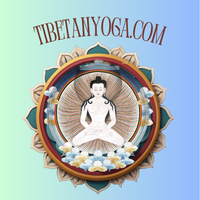
So just what is Tibetan Yoga, or Tsa Lung Trul Khor? Is it just a fancy name for yoga, the practice of movement and breath that you can find in studios and gyms all across the world? Or, is it something different? And, what on earth makes the movements “magical”?
If you look at the image above, you can see that it is definitely something different. The movements don’t look much at all like hatha, vinyasa, ashtanga or kundalini yoga. Not only does it look different, but the breath used in the movements is almost oppositional to traditional forms of yoga. Rather than letting the breath flow with movement or breathing while holding the body in a static position, Tibetan Yoga has us holding our breath while dynamically moving the body. These movements are usually in the form of circling, folding, twisting, striking or rolling. At the end of each movement there is a jumping or shaking of the body and a forceful expelling of the breath (with sounds of “Ha” and “Phet”) along with the release of any stale energy or obstacles to our clarity, health and well being.
So, Tibetan yoga looks very different from other forms of yoga, but the intentionality of each posture and the spiritual framework for the practice is also more explicit in this tradition. In the texts, the postures and sets of postures are described in terms of what physical, mental and spiritual obstacles they clear, what benefits they provide, and the kinds of meditative experiences that they contribute to. At the end of each movement, with the shaking and exhaling and verbalizing, we cultivate compassion (bodhicitta) for all sentient beings, and we use the power of the movement and the exhalation of the breath to clear not only our own negativities and afflictions, but those of all beings everywhere. We do this again and again, with every movement. The practice is not only for ourselves, it is for the benefit of everyone.
These differences don’t make Tsa Lung Trul Khor better than other forms of yoga or contemplative movement, or even ultimately bring about different results (health and wellness for ourselves and compassion for all beings is an inherent part of all contemplative practice!). But, the yogis of Tibet and Nepal did use them differently, with the goal that these practices were specifically a support for meditation and ultimately liberation or Buddhahood in this very lifetime. The practices were taught after extensive training in meditation and also pranayama. The body came last. In other yoga systems we start with the body (usually), and work toward meditation and ultimately samadhi (a deep meditative state).
In the programs on this site, I have tried to blend to the models. What is offered is decidedly Tibetan yoga. But, most of us don’t start with lots of meditation experience. Most of us work with the body first, getting to meditation somewhere down the road if we are lucky. Here, we start with the breath, then add some movement. As we learn these things, attention is given to the states of mind that we want to cultivate and the states that we want to abandon or at least lesson, but it isn’t the initial emphasis. Once our body and especially the energetics of our body become more grounded, clear and open, then we can start to bring meditation into the picture. Here on this site, I will bring the meditation in later on.
If you have a meditation experience, wonderful! Keep it going. Nothing can change us more profoundly than taming and perfecting our mindstream. These practices can support and enhance meditation. And if you don’t have an interest in meditation (yet!) these practices still bring many benefits. This is their magic - the magic of being medicine. Holding the breath, focusing our awareness on a single point within the body and in the breath, moving in the prescribed ways - the movements just clear obstacles and hinderances out of our systems. It’s just like when we take medicine prescribed by a physician, we don’t need to know what it does, its mechanism of action, or its chemistry. Medicine just works. These movements just clear anger, reduce jealousy, tame our pride, restore us when we are drowsy and calm us when we are agitated. If you become familiar with them, they can work for you. It’s that easy.
These ideas of enhancing positive qualities and removing obstacles are very clearly articulated in the teachings of Tibetan Yoga. The concepts are bogdun and geksel respectively. Topics for a future blog or blogs.
If you have not already, please try the nine breaths course. It’s a kind of panacea for clearing challenging things out and bringing more awareness and wisdom into each moment. It’s easy. It’s free. It’s powerful. This breath is the place to give Tibetan yoga a try, and to see if it is something you want to bring into you life.
In service,
Rob

Comments